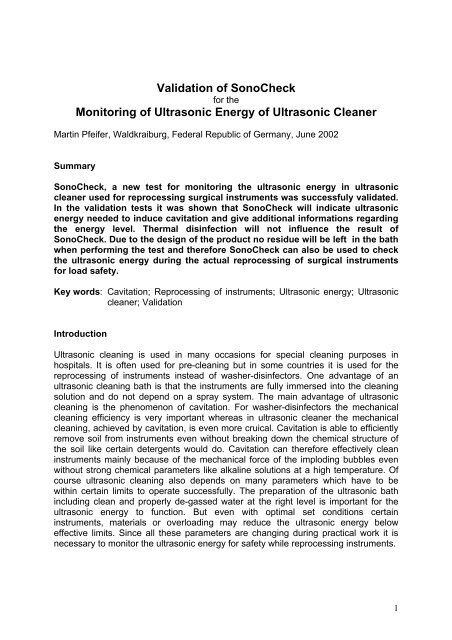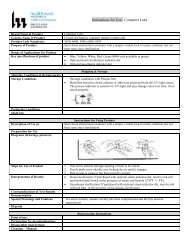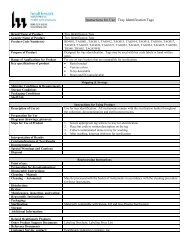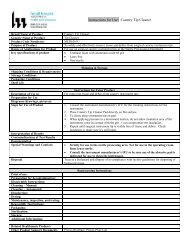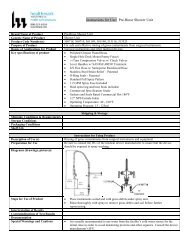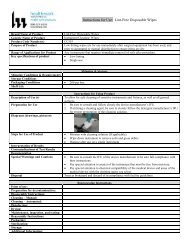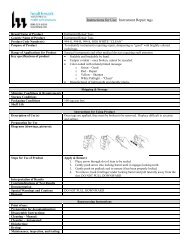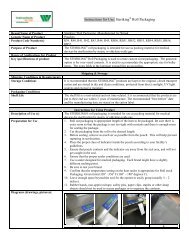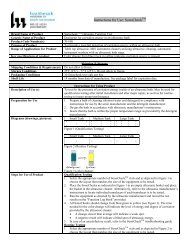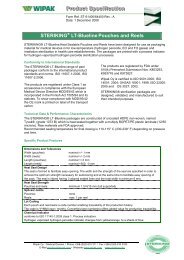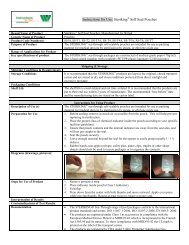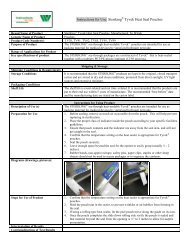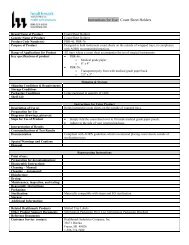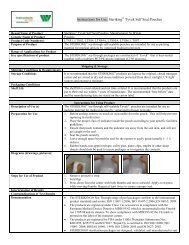Validation of SonoCheck
Validation of SonoCheck
Validation of SonoCheck
Create successful ePaper yourself
Turn your PDF publications into a flip-book with our unique Google optimized e-Paper software.
<strong>Validation</strong> <strong>of</strong> <strong>SonoCheck</strong><br />
for the<br />
Monitoring <strong>of</strong> Ultrasonic Energy <strong>of</strong> Ultrasonic Cleaner<br />
Martin Pfeifer, Waldkraiburg, Federal Republic <strong>of</strong> Germany, June 2002<br />
Summary<br />
<strong>SonoCheck</strong>, a new test for monitoring the ultrasonic energy in ultrasonic<br />
cleaner used for reprocessing surgical instruments was successfuly validated.<br />
In the validation tests it was shown that <strong>SonoCheck</strong> will indicate ultrasonic<br />
energy needed to induce cavitation and give additional informations regarding<br />
the energy level. Thermal disinfection will not influence the result <strong>of</strong><br />
<strong>SonoCheck</strong>. Due to the design <strong>of</strong> the product no residue will be left in the bath<br />
when performing the test and therefore <strong>SonoCheck</strong> can also be used to check<br />
the ultrasonic energy during the actual reprocessing <strong>of</strong> surgical instruments<br />
for load safety.<br />
Key words: Cavitation; Reprocessing <strong>of</strong> instruments; Ultrasonic energy; Ultrasonic<br />
cleaner; <strong>Validation</strong><br />
Introduction<br />
Ultrasonic cleaning is used in many occasions for special cleaning purposes in<br />
hospitals. It is <strong>of</strong>ten used for pre-cleaning but in some countries it is used for the<br />
reprocessing <strong>of</strong> instruments instead <strong>of</strong> washer-disinfectors. One advantage <strong>of</strong> an<br />
ultrasonic cleaning bath is that the instruments are fully immersed into the cleaning<br />
solution and do not depend on a spray system. The main advantage <strong>of</strong> ultrasonic<br />
cleaning is the phenomenon <strong>of</strong> cavitation. For washer-disinfectors the mechanical<br />
cleaning efficiency is very important whereas in ultrasonic cleaner the mechanical<br />
cleaning, achieved by cavitation, is even more cruical. Cavitation is able to efficiently<br />
remove soil from instruments even without breaking down the chemical structure <strong>of</strong><br />
the soil like certain detergents would do. Cavitation can therefore effectively clean<br />
instruments mainly because <strong>of</strong> the mechanical force <strong>of</strong> the imploding bubbles even<br />
without strong chemical parameters like alkaline solutions at a high temperature. Of<br />
course ultrasonic cleaning also depends on many parameters which have to be<br />
within certain limits to operate successfully. The preparation <strong>of</strong> the ultrasonic bath<br />
including clean and properly de-gassed water at the right level is important for the<br />
ultrasonic energy to function. But even with optimal set conditions certain<br />
instruments, materials or overloading may reduce the ultrasonic energy below<br />
effective limits. Since all these parameters are changing during practical work it is<br />
necessary to monitor the ultrasonic energy for safety while reprocessing instruments.<br />
1
Materials and methods<br />
1. General requirements<br />
<strong>Validation</strong> is the pro<strong>of</strong> a certain method will reproducible fulfil the requirements for its<br />
intended use (Lit. 1). For successful ultrasonic cleaning sufficient energy level is<br />
necessary to induce cavitation responsible for the mechanical cleaning effects. A test<br />
to monitor the ultrasonic energy therefore has to indicate positive parameters for<br />
cavitation. For example an existing test, the foil test (picture 1 / Lit. 2) will achieve this<br />
by perforating a thin aluminium foil ( 60 X 70 X 0.025mm, picture 2). The new<br />
developed <strong>SonoCheck</strong> (picture 3) will indicate sufficient ultrasonic energy levels for<br />
cavitation by a colour change from green to yellow (picture 4)caused by a chemical<br />
reaction triggered by cavitation. This type <strong>of</strong> chemical reaction where chlorine or<br />
hydrochloric acid is released from an organic molecule is generally referred to as the<br />
dosimeter for cavitation (Lit.: 3) A positive function <strong>of</strong> an ultrasonic cleaner has to be<br />
clearly indicated as well as a non functioning one. Additional information regarding<br />
equipment with reduced energy level will be helpful for trouble shooting and<br />
optimisation. Parameters used during the reprocessing cycle other than ultrasonic<br />
waves like hot water should not give a positive result.<br />
picture 1: Foil test (negative<br />
result); magnified 10 times<br />
picture 3: <strong>SonoCheck</strong><br />
before use (negative<br />
result)<br />
2. Test methods<br />
picture 2: Foil test perforated by<br />
cavitation (positive result);<br />
magnified 10 times<br />
picture 4: <strong>SonoCheck</strong><br />
(positive result)<br />
2
2.1) Influence <strong>of</strong> hot water<br />
High temperatures for reprocessing <strong>of</strong> surgical instruments are either used during the<br />
washing stage to increase the efficiency <strong>of</strong> alkaline detergents or for disinfectioning<br />
purposes. When checking the influence <strong>of</strong> heat, water at 95°C was applied for 10<br />
minutes. This temperature test was repeated 6 times with <strong>SonoCheck</strong> and the foil<br />
test (Aluminium foil: 80X80X0.020 mm).<br />
2.2) Indication <strong>of</strong> cavitation and correlation with existing test<br />
For the indication <strong>of</strong> cavitation 2 <strong>SonoCheck</strong> tests were placed into an ultrasonic bath<br />
(Bandelin Sonorex TK 30, 36/144 W, 50 kHz) like shown in picture 5. The bath was<br />
filled to the right level with 1050 ml demin. water at 35°C without detergent and was<br />
de-gassed for 15 minutes. All the tests were done simultaneous with the foil test, a<br />
test which is already known and used to test ultrasonic cleaner. The cycle used for<br />
the ultrasonic cleaner was 4 minutes. The test was repeated 6 times and the results<br />
are shown in table 1. By placing silicone a material known to absorb ultrasonic<br />
energy into the bath the energy level was reduced below the necessary limit for<br />
cavitation. For this test the cycle was increased from 4 minutes to 8 minutes.<br />
picture 5: location <strong>of</strong> the tests in the<br />
ultrasonic bath<br />
2.3) Reading <strong>of</strong> ultrasonic energy levels<br />
○ <strong>SonoCheck</strong><br />
I Foil test<br />
In addition to the yes/no answer if the ultrasonic energy is sufficient to induce<br />
cavitation, the time needed for the colour change will give informations regarding the<br />
energy level. For testing if <strong>SonoCheck</strong> can also indicate cavitation amongst<br />
instruments in a cleaning bath the same equipment and test preparation was used<br />
again (picture 5), but with an instrument load reducing the ultrasonic energy. To<br />
simulate a heavy instrument load, the ultrasonic basket was loaded with 15 stainless<br />
steel LumCheck devices.<br />
3
3. Results (table 1)<br />
3.1 Water at 95°C (table 1 / column 1)<br />
Both methods tested did not show any cacvitation, meaning no colour change <strong>of</strong><br />
<strong>SonoCheck</strong> and no perforation <strong>of</strong> the foil. Negative results are shown in the table by<br />
a minus (-)<br />
3.2 Functional ultrasonic cleaner (table 1 / column 2)<br />
All <strong>SonoCheck</strong> vials changed to yellow after the ultrasonic cycle indicating a positive<br />
result. The actual time needed for the colour change was between 20 to 25 seconds.<br />
The foil test was removed after 30 seconds to prevent complete destruction <strong>of</strong> the<br />
foil. All foil tests showed perforation after removal indicating a positive result. Positive<br />
results are shown in the table by a plus (+).<br />
3.3 Non functional ultrasonic cleaner (table 1 / column 3)<br />
Neither the <strong>SonoCheck</strong> vials nor did the foil test indicated cavitation after the 8<br />
minutes cycle indicating a negative result.<br />
3.4 Ultrasonic cleaner with instrument load (table 1 / column 4)<br />
<strong>SonoCheck</strong> did indicate cavitation with a longer time needed for the colour change (2<br />
to 2,5 minutes). The foil test cannot be placed amongst the instruments .<br />
<strong>SonoCheck</strong><br />
Foil test<br />
table 1<br />
Water<br />
at<br />
95°C/10<br />
min<br />
- - -<br />
- - -<br />
- - -<br />
- - -<br />
Functional<br />
ultrasonic cleaner<br />
(4 minutes cycle)<br />
A B A B A B<br />
+ + + + + +<br />
A B A B A B<br />
+ + + + + +<br />
A B A B A B<br />
+ + + + + +<br />
A B A B A B<br />
+ + + + + +<br />
Non functional<br />
ultrasonic cleaner<br />
(8 minutes cycle)<br />
A B A B A B<br />
- - - - - -<br />
A B A B A B<br />
- - - - - -<br />
A B A B A B<br />
- - - - - -<br />
A B A B A B<br />
- - - - - -<br />
Ultrasonic cleaner<br />
with instrument<br />
load<br />
(4 minutes cycle)<br />
A B A B A B<br />
+ + + + + +<br />
A B A B A B<br />
+ + + + + +<br />
N/A<br />
4
Discussion<br />
<strong>SonoCheck</strong> can reproducible indicate necessary energy level for cleaning by means<br />
<strong>of</strong> cavitation, therefore the new designed monitor for ultrasonic cleaner has been<br />
successfully validated. An easy to read colour change from green to yellow will<br />
indicate cavitation. In addition the time needed for the colour change will give useful<br />
information regarding the level <strong>of</strong> ultrasonic energy. The pre-prepared and closed<br />
design <strong>of</strong> <strong>SonoCheck</strong> helps to perform a reproducible test <strong>of</strong> the ultrasonic cleaner<br />
without leaving residues behind. <strong>SonoCheck</strong> is therefore excellent to monitor the<br />
ultrasonic efficiency amongst the instruments for load safety. This is difficult to be<br />
performed with the foil test because <strong>of</strong> aluminium residue left behind and possible<br />
reaction with alkaline detergent used. Sonocheck can monitor the ultrasonic energy<br />
for routine use as well as it can be used for optimisation during a functional test.<br />
Different levels <strong>of</strong> ultrasonic energy in ultrasonic cleaner (Lit. 4) are especially<br />
important and may further enhance weak spots in a loaded ultrasonic cleaner.<br />
References<br />
1. Kromidas S.,Validierung in der Analytik; Wiley-VCH, 1999<br />
2. Australian Standard; AS 2773.2, 1999: Ultrasonic cleaners for health care<br />
facilities<br />
3. Suslick, K. S., ed. Ultrasound: Ist Chemical, Physical, and Biological Effects;<br />
VCH Publishers: New York 1988<br />
4. Zentr Steril; Volume 8, 2000: Empfehlungen des AK “Qualität” (9): Reinigung<br />
und Desinfektion im Ultraschallbad (Teil 2)<br />
5


